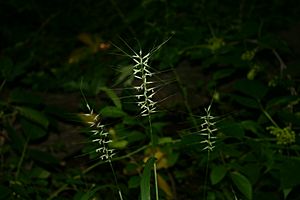Bottlebrush grass facts for kids
Quick facts for kids Bottlebrush grass |
|
|---|---|
 |
|
| Inflorescences | |
| Scientific classification | |
| Genus: |
Elymus
|
| Species: |
hystrix
|
| Synonyms | |
|
Hystrix patula Moench |
|
Elymus hystrix, often called eastern bottlebrush grass, is a type of grass that grows in clumps. It belongs to the grass family, Poaceae. You can find it growing naturally in the Eastern United States and Eastern Canada.
Contents
What Bottlebrush Grass Looks Like
Bottlebrush grass is a green plant that doesn't have a woody stem, like a tree. It has simple leaves that grow one after another on straight stems. Its flowers are white and usually appear in the spring.
This grass can grow to be about two and a half to four and a half feet tall. It typically has two small flower clusters, called spikelets, at each of its five to nine nodes (the points on the stem where leaves or branches grow). Unlike some other native grasses, bottlebrush grass doesn't have special leaf-like parts called glumes around its spikelets.
Bottlebrush grass can make seeds using its own pollen. This means it can reproduce by itself. It's also a perennial plant, which means it doesn't die completely each year. Instead, it grows back from its roots the next spring.
This plant is special because it has four copies of its genome (all its genetic information). This is a type of polyploidy called tetraploidy.
How Bottlebrush Grass Got Its Name
The famous scientist Carl Linnaeus first described Elymus hystrix in 1753. Later, in 1794, another scientist named Conrad Moench moved it to a new group of plants called Hystrix. He named it Hystrix patula.
However, studies of the plant's genes starting in the 1960s showed that it actually belongs in the Elymus group. That's why it's now known as Elymus hystrix again.
Where It Grows and Lives
You can find Elymus hystrix in the United States, east of the Great Plains, and also in Eastern Canada. It likes to grow in places that are rocky, a bit wet, and partly shaded. You might see it near rivers, creeks, or in wooded areas.
Bottlebrush grass doesn't grow well in very shady spots. It often prefers the edges of forests or other shaded areas. While too much shade can stop it from growing, it's pretty good at growing even if the soil is a bit squished or compacted.
Could We Eat Bottlebrush Grass?
Small animals like mice eat the seeds of Elymus plants. Scientists think that if we could make the seeds bigger and more nutritious, humans might be able to eat them too. Other types of Elymus grasses are already eaten by livestock (farm animals) across the United States.
Some Elymus species have a lot of protein, more than other native grasses. But we need more research to see if Elymus hystrix specifically has this trait. It's also not clear how nutritious the green parts of the plant would be for humans. However, its potential as a food source for farm animals is also something scientists are interested in.
Bottlebrush Grass in Nature
Elymus hystrix is an important plant for the northern pearly eye butterfly. The caterpillars of this butterfly eat the leaves of bottlebrush grass as they grow. This makes the grass a "larval host" for the butterfly.

